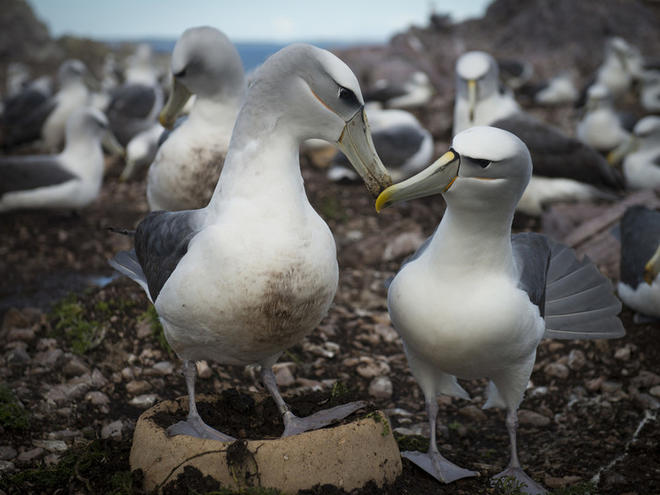
Dozens of fluffy shy albatross chicks sitting on artificial nests are a promising sign for scientists behind an innovative plan to give the vulnerable species a boost to help counteract the negative impacts of climate change.
Over 100 specially built mudbrick and aerated concrete artificial nests were airlifted on to Bass Strait’s Albatross Island off the northwest coast of Tasmania in July 2017 to trial a program aimed at increasing the breeding success of the shy albatross.
Higher air temperatures and increased rainfall associated with climate change are reducing breeding success for Australia’s only albatross, and the rapid warming of the ocean may also make it harder for foraging parents to find prey. Monitoring shows that birds with inferior nests are less likely to successfully raise a chick.
Luckily, the artificial nests appear to be working.
“Shy albatross lay a single egg in late September and those eggs have now hatched,” said Dr. Rachael Alderman, a biologist with the Tasmanian Department of Primary Industries, Parks, Water and Environment. “At this stage in the trial, the breeding success of pairs on artificial nests is 20% higher than those on natural nests. There are many more months ahead for all the chicks, and a lot can change, but so far it’s very promising.”
Endemic to Australia, shy albatross only nest on three islands off the coast of Tasmania—Albatross Island, Pedra Branca, and Mewstone. In some parts of the Albatross Island colony, birds struggle to find and keep sufficient nesting material, resulting in poor quality nests.
Conservation scientists and funding partners from the Tasmanian and Australian governments, WWF-Australia, WWF's Wildlife Adaptation Innovation Fund, CSIRO Marine Climate Impact, and the Tasmanian Albatross Fund have worked together to place nests in areas where they were typically of lower quality. Recent monitoring shows that the birds are accepting the nests and personalizing them with mud and vegetation.
“Albatross Island gets hit with wild weather,” said Darren Grover, WWF-Australia’s head of living ecosystems who recently visited the project site. “Good quality nests keep eggs and chicks safe and sound. The artificial nests were all intact, but many of the natural nests were already starting to deteriorate. That’s not the best start in life for a chick.”
When the chicks are fully grown and about to fly from the island for the first time, scientists will attach tiny satellite trackers to them to capture the movements of their first few months at sea. This will provide crucial information about why fewer juveniles are surviving.
As the climate continues to change, scientists need to develop, test, and evaluate new approaches to protecting vulnerable species. This collaborative innovation is an encouraging step for the future of the shy albatross and can serve as a model for other wildlife recovery efforts.
“It’s fantastic to see this project come to fruition,” said Dr. Sally Box, Australia’s threatened species commissioner. “We all have a role to play in protecting our threatened species, and thanks to contributions by government, scientists, and non-government partners, we are starting to see some really positive outcomes for the shy albatross in Tasmania.”
Published February 15, 2018 at 06:00AM
No comments:
Post a Comment